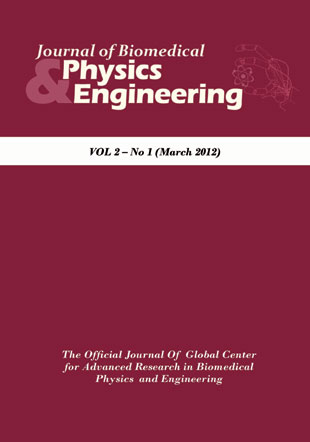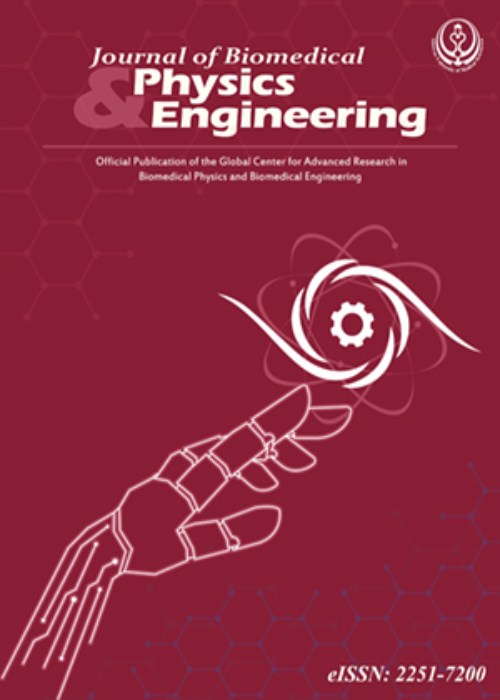فهرست مطالب

Journal of Biomedical Physics & Engineering
Volume:2 Issue: 1, Jan-Feb 2012
- تاریخ انتشار: 1390/10/11
- تعداد عناوین: 6
-
-
Page 1BackgroundThe Patterson-Parker table was created in 1934 to determine mg-hr required to deliver the prescribed dose to the treatment area. These tables were created using the dosimetric data for 226Ra that was determined in air and were utilized for dose calculations around implants with Ra-equivalent radionuclides such as 137Cs and 192Ir. Therefore, the differences of the tissue attenuation and anisotropy of these radionuclides and their impact on dose uniformity of the implants were ignored.ObjectiveIn this study, the Patterson-Parker table has been updated for 137Cs and 192Ir sources using their recent dosimetric data. Furthermore, the dose uniformity for different loading schemes, as a function of the implant area, was tested.MethodsThe updated Paterson-Parker tables were generated for 137Cs and 192Ir sources using their published dosimetric parameters that have been determined following the American Association of Physicists in Medicine (AAPM) Task group 43 (TG-43U1) recommendations. The accuracies of the updated tables were examined by two independent methods, Monte Carlo simulation technique and a commercially available treatment planning system. In addition to the dose values along the central axis of the implant, dose profiles along two orthogonal directions were evaluated for the selection of the optimal radioactivity distribution in an implant.ResultsWe found that the original Paterson-Parker loading scheme of the radioactivity as a function of the implant size has to be adjusted to achieve the optimal dose distribution (1000 cGy ±10%) in an implant. In addition, it was shown that the same implant size for the mg-hr required for 137Cs was not identical to that of 192Ir. Similarly, there were some differences between the updated table and the published Paterson-Parkers tables. Independent Monte Carlo simulations and treatment planning data had excellent agreement with the updated data.ConclusionThe conventional version of Paterson-Parker tables are not useful for the two commonly used brachytherapy sources. The updated version of the tables should be used instead.
-
Page 16BackgroundFunctional electrical stimulation (FES) is the most commonly used system for restoring functions after spinal cord injury (SCI).ObjectiveIn this study we investigated feedback PID and feedforward-feedback P-PID controllers for regulating the elbow joint angle.MethodsThe controllers were tuned based on a nonlinear muculoskeletal model containing two links, one joint with one degree of freedom and two muscles in the sagittal plane that was simulated in MATLAB using Sim Mechanics and Simulink toolboxes. The first tune of the PID and P-PID controllers was done by trial and error. Then, the coefficients were optimized by genetic algorithm (GA). For checking the robustness of the controllers, we compared the amount of rise time, settling time, maximum overshoot and steady state error under three conditions: the first was when the initial angle of the joint was fixed and only the desired angles changed; the second was with a fixed step as input and various initial angles; and the last condition was with different maximum forces for muscle.ResultsGenetic controllers had better performance than the trial and error tuned controllers. The amounts of settling time were not so different for the controllers in condition 1 but had more variations in condition 2 and had really better results in genetic P-PID in condition 3. The overshoot was pretty less in PIDs than in P-PIDs and the steady state error was almost zero for all of the controllers.ConclusionGenetic controllers had a better performance than the trial and error tuned controllers. The rise time was much less in P-PIDs than in PIDs.
-
Page 27BackgroundMany radioactive compounds may be released into the environment and hence into the drinking water supplies due to the human activities. Radionuclides can also enter the food chain if the contaminated water is used for drinking or irrigation purposes.ObjectiveTo estimate the annual effective dose of natural radioactive materials like 226Ra and 40K in drinking water of wells in Zanjan, nortwestern Iran.Methods82% of drinking water in Zanjan comes from drilled wells. Water samples from the main sites of drinking water from different parts of Zanjan were collected. The amount of 226Ra and 40K were measured by gamma-ray spectrometry using a NaI (Tl) detector. The annual effective dose of the radioactive materials was calculated for children (2–7 years old) and adults (≥17 years old) with annual water intake of 350 and 500 L, respectively. The annual effective dose received by residents of the city due to consumption of the contaminated drinking water was also calculated.ResultsThe mean±SD concentrations of 226Ra and 40K were 32.4±7.8 and 20.5±27.4 Bq/L, respectively. The mean±SD annual effective dose received by residents of the city due to consumption of the contaminated drinking water was 7.13±1.76 and 4.59±1.12 mSv/y for children and adults, respectively.ConclusionThe level of radioactive compounds in water of drilled wells in Zanjan is significantly higher than the ICRP permissible limit of 1 mSv/y.
-
Page 31BackgroundGTS, PTSM and ATSM are bis-thiosemicarbazone ligands used in the preparation of copper radiopharmaceuticals. Chemical structure of these materials indicates that they should have radio-protective effects.ObjectiveTo study the radio-protective effects of GTS, PTSM and ATSM.MethodsThis study has focused on radio-protective effects of these compounds at different doses (20, 40 and 80 μg) and with time intervals of 1 and 4 h before the whole-body gamma-irradiation. The survival curves were plotted for different groups after one month post-irradiation. The effective doses of these compounds were also calculated from the survival study. In the next step, biochemical markers of hepatic function, aspartate aminotransferase (AST) and alanine aminotransferase (ALT) were determined in a hepatotoxicity study.ResultsAdministration of ATSM did not cause any serious side effects and hepatotoxicity in a mice model—AST and ALT enzyme levels in a group of animals that received 80 μg of ATSM showed no significant difference with that in the control group. However, AST and ALT enzymes rose significantly in those mice that received 40 μg of GTS compared to the control group even 7 days post-injection.ConclusionIt seems that ATSM is a better candidate on which to carry out further research for protection against irradiation.
-
Page 37Annually, many people are irradiated for diagnostic and therapeutic purposes. Assessment of radiation dose and its related risks to patients are important issues in radiation protection dosimetry. The complex mathematical calculations of the absorbed and effective doses are now done with computers. The calculations are performed with the help of anthropomorphic computational models of human body called phantoms and Monte Carlo codes (MCNP). There are various types of phantoms, yet the latest type is hybrid phantom which has been introduced to the scientific community in recent years. Hybrid phantom is the connection between mathematical and voxel phantoms. They retain both the anatomic realism of voxel phantoms and the flexibility of mathematical phantoms. Using hybrid phantoms, the absorbed doses can be determined for any patients before they are exposed to radiation. Then, the energy of the emitted particles and irradiation geometry can be determined for any special purposes. We constructed hybrid phantoms for Iranian patients to be used in different applications such as testing new radiopharmaceuticals or cancer treatments with high LET radiation. Herein, we report on our findings.


